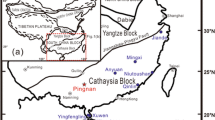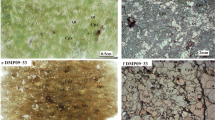Abstract
We performed a combined study of He–Ar isotopes and element geochemistry for pyroxene megacrysts and mantle xenoliths from Cenozoic basalt in the Changle–Linqu area in western Shandong. The results are used to trace the evolution of subcontinental lithospheric mantle after destruction of the North China Craton. The 3He/4He ratios of pyroxene megacrysts, websterite, and dunites are 7.0–7.7 Ra, 7.4 Ra, and 7.0–7.7 Ra, respectively. They are related to the origin of host basalts, and are slightly lower than that of mid-ocean ridge basalts (MORB). Their 40Ar/36Ar ratios are much lower than that of MORB and close to that of air. The lherzolites and wehrlites represent the fragments of the newly accreted lithospheric mantle, and their REE and trace elements indicate that they experienced melt metasomatism and partial melting. The 3He/4He ratios of their olivine are slightly lower than that of MORB, but 3He/4He ratios of their clinopyroxene are low (2.3–7.1 Ra) and display an inverse correlation with (La/Yb)N. The 40Ar/36Ar ratios of these clinopyroxene are much lower than that of MORB and close to the air ratio. Combining existing studies of petrology, Sr–Nd–Pb isotopes, O isotopes, trace elements, and Mg isotopes, we infer that the juvenile lithospheric mantle in the Changle–Linqu area was metasomatized by oceanic crust-derived melts, which transfer the supracrustal Ar isotope signatures to the mantle sources. The low 4He abundance and low 3He/4He ratios of clinopyroxene in the lherzolites and wehrlites are ascribed to metasomatism by crustal melts from the subducted Pacific plate.







Similar content being viewed by others
References
Gonnermann HM, Mukhopadhyay S (2009) Preserving noble gases in a convection mantle. Nature 459:560–563
Ozima M, Podosek FA (2002) Noble gas geochemistry, 2nd edn. Cambridge University Press, Cambridge
Starkey NA, Stuart FM, Ellam RM et al (2009) Helium isotopes in early Iceland picrites: constraints on the composition of high 3He/4He mantle. Earth Planet Sci Lett 277:91–100
Hilton DR, Procelli D (2003) Noble gases as mantle tracers. In: Holland HD, Turekian KK (eds) Treatise on geochemistry. Elsevier, New York, pp 277–318
Martelli M, Bianchini G, Beccaluve L et al (2011) Helium and argon isotopic compositions of mantle xenoliths from Tallante and Calatrava, Spain. J Volcano Geotherm Res 200:18–26
Stuart FM, Burnard PG, Taylor RP et al (1995) Resolving mantle and crustal contributions to ancient hydrothermal fluids: He-Ar isotopes in fluid inclusions fron Dae Hwa W-Mo mineralization, South Korea. Geochim Cosmochim Acta 59:4663–4673
Zheng JP, O’Reilly SY, Griffin WL et al (1998) Nature and evolution of Cenozoic lithospheric mantle beneath Shandong peninsula, Sino-Korean craton. Int Geol Rev 40:471–499
Xu YG, Chung SL, Ma JL et al (2004) Contrasting Cenozoic lithospheric evolution and architecture in the eastern and western Sino-Korean craton: constraints from geochemistry of basalts and mantle xenoliths. J Geol 112:593–605
Chen L, Zheng TY, Xu WW (2006) A thinned lithospheric image of the Tanlu Fault Zone, eastern China: constructed from wave equation based receiver function migration. J Geophys Res. doi:10.1029/2005JB003974
Xiao Y, Zhang H, Fan W et al (2010) Evolution of lithospheric mantle beneath the Tan-Lu fault zone, eastern North China Craton: evidence from petrology and geochemistry of peridotite xenoliths. Lithos 117:229–246
Ying JF, Zhang HF, Kita N et al (2006) Nature and evolution of late cretaceous lithospheric mantle beneath the eastern North China Craton: constraints from petrology and geochemistry of peridotitic xenoliths from Junan, Shandong Province, China. Earth Planet Sci Lett 244:622–638
Zhang J, Zhang HF, Kita N et al (2011) Secular evolution of the lithospheric mantle beneath the eastern North China Craton: evidence from peridotitic xenoliths from Late Cretaceous mafic rocks in the Jiaodong region, east-central China. Int Geol Rev 53:182–211
Ma JL, Tao MX, Ye XY (2005) Characteristics and origins of primary fluids and noble gases in mantle-derived minerals from the Yishu area, Shandong Province, China (in Chinese). Sci China Ser D 35:1019–1027
Hu W, Song Y, Chen X et al (2006) Noble gases in corundum megacrysts from the basalts in Changle, Shandong Province, eastern China (in Chinese). Chin Sci Bull 51:2526–2533
Tang HY, Zheng JP, Yu CM (2007) Mantle fluids and noble gas isotopic compositions of peridotite olivines in Cenozoic basalts from eastern North China. Acta Petrol Sin 23:1531–1542 (in Chinese)
He HY, Zhu RX, Saxton J (2011) Noble gas isotopes in corundum and peridotite xenoliths from the eastern North China Craton: implications for comprehensive refertilization of lithospheric mantle. Phys Earth Planet Inter 189:185–191
Xu Z, Zhao ZF, Zheng YF (2012) Slab–mantle interaction for thinning of cratonic lithospheric mantle in North China: geochemical evidence from Cenozoic continental basalts in central Shandong. Lihtos 146–147:202–217
He HY, Deng CL, Pan YX et al (2011) New 40Ar/39Ar dating results from the Shanwang Basin, eastern China: constraints on the age of the Shanwang Formation and associated biota. Phys Earth Planet Inter 187:66–75
Pouchou JL, Pichoir F (1991) Quantitative analysis of homogeneous or stratified micro volumes applying the model “PAP”. In: Heinrich KFJ, Newbury DE (eds) Electron probe quantification. Plenum Press, New York, pp 31–75
Sun SS, McDonough WF (1989) Chemical and isotopic systematic of oceanic basalt: implication for mantle composition and process. In: Saunders AD, Norry MJ (eds) Magmatism in the oceanic basins. Spec Publ, vol 42. Geological Society, London, pp 313–345
McDonough WF, Sun SS (1995) The composition of the Earth. Chem Geol 120:223–253
Moreira M, Madureira P (2005) Cosmogenic helium and neon in 11 Myr old ultramafic xenoliths: Consequences for mantle signatures in old samples. Geochem Geophys Geosys. doi:10.1029/2005GC000939
Matsuda J, Matsumoto T, Sumino H et al (2002) The 3He/4He ratio of the new internal He Standard of Japan (HESJ). Geochem J 36:191–195
Xiao Y, Zhang HF, Fan WM (2008) Origin of clinopyroxene megacrysts in the late Mesozoic and Cenozoic basalts from the North China Craton and their constraints on the magma process of host rocks: a case of Junan and Hebi. Acta Petrol Sin 24:65–76 (in Chinese)
Coltorti M, Bonadiman C, Hinton RW et al (1999) Carbonatite metasomatism of the oceanic upper mantle: evidence from clinopyroxenes and glasses in ultramafic xenoliths of Grande Comore, India Ocean. J Petrol 40:133–165
Yamamoto J, Nishimura K, Sugimoto T et al (2009) Diffusive fraction of noble gases in mantle with magma channels: origin of low He/Ar in mantle- derived rocks. Earth Planet Sci Lett 280:167–174
Wu FY, Xu YG, Gao S et al (2008) Lithospheric thinning and destruction of the North China Craton. Acta Petrol Sinica 24:1145–1174 (in Chinese)
Zhu RX, Zheng TY (2009) Destruction geodynamics of the North China Craton and its Paleoproterozoic plate tectonics. Chin Sci Bull 54:1950–1961 (in Chinese)
Zhu RX, Xu YG, Zhu G et al (2012) Destruction of the North China Craton. Sci China Ser D 55:1135–1159 (in Chinese)
Zheng YF, Wu FY (2009) Growth and reworking of cratonic lithosphere. Chin Sci Bull 54:1945–1949 (in Chinese)
Zhang HF, Sun M, Zhou XH et al (2003) Secular evolution of the lithosphere beneath the eastern North China Craton: evidence from Mesozoic basalts and high-Mg andesites. Geochim Cosmochim Acta 67:4373–4387
Zheng JP, Griffin WL, Ma Q et al (2012) Accretion and reworking beneath the north China Craton. Lithos 149:61–78
Zhang HF (2005) Transformation of lithospheric mantle through peridotite-melt reaction: a case of Sino-Korean craton. Earth Planet Sci Lett 237:768–780
Gautheron C, Moreira M (2002) Helium signature of the subcontinental lithospheric mantle. Earth Planet Sci Lett 199:39–47
Gautheron C, Moreira M, Allegre C (2005) He, Ne and Ar composition of the European lithospheric mantle. Chem Geol 217:97–112
Czuppon G, Matsumoto T, Handler MR et al (2009) Noble gas in spinel peridotite xenoliths from Mt Quincan, North Queensland, Australia: undisturbed MORB-type noble gases in the subcontinental lithospheric mantle. Chem Geol 266:19–28
Sapienza G, Hilton DR, Scribano V (2005) Helium isotopes in peridotite mineral phase from Hyblean Plateau xenoliths (south-eastern Sicily, Italy). Chem Geol 219:115–129
Correale A, Martelli M, Paonita A et al (2012) New evidence of mantle heterogeneity beneath the Hyblean Plateau (southeast Sicily, Italy) as inferred from noble gases and Geochemistry of ultramafic xenoliths. Lithos 132–133:70–81
Porcelli D, Ballentine CJ (2002) Models for distribution of terrestrial noble gases and evolution of the atmosphere. Rev Mineral Geochem 47:411–480
Zhang JJ, Zheng YF, Zhao ZF (2009) Geochemical evidence for interaction between oceanic crust and lithospheric mantle in the origin of Cenozoic continental basalts in east-central China. Lithos 110:305–326
Burnard P, Graham D, Turner G (1997) Vesicle-specific noble gas analyses of “popping rock”: implications for primordial noble gases in Earth. Science 276:568
Hopp J, Trieloff M (2005) Refining the noble gas record of the Reunion mantle plume source: implications on mantle geochemistry. Earth Planet Sci Lett 240:573–588
Blard PH, Puchol N, Farley KA (2008) Constraints on the loss of matrix-sited helium during vacuum crushing of mafic phenocrysts. Geochim Cosmochim Acta 75:3788–3803
Matsumoto T, Pinti DL, Matsuda J et al (2002) Recycled noble gas and nitrogen in the subcontinental lithospheric mantle: Implications from N-He-Ar in fluid inclusions of SE Australian xenoliths. Geochem J 36:209–217
Zheng YF (2012) Metamorphic chemical geodynamics in continental subduction zones. Chem Geol 328:5–48
Wang Y, Zhao ZF, Zheng YF et al (2011) Geochemical constraints on the nature of mantle source for Cenozoic continental basalts in east-central China. Lithos 125:940–955
Yang W, Teng FZ, Zhang HF et al (2012) Magnesium isotopic systematic of continental basalts from the North China Craton: implications for tracing subducted carbonate in the mantle. Chem Geol 328:185–194
Acknowledgments
The authors thank Prof. Yong Fei Zheng, Hong Fu Zhang, Jian Ping Zheng, and Chuan Zhou Liu for their constructive suggestions which have significantly improved the manuscript. This work was supported by the National Basic Research Program of China (2009CB825001) and the National Natural Science Foundation of China (90714010).
Author information
Authors and Affiliations
Corresponding author
About this article
Cite this article
Su, F., Xiao, Y., He, H. et al. He and Ar isotope geochemistry of pyroxene megacrysts and mantle xenoliths in Cenozoic basalt from the Changle–Linqu area in western Shandong. Chin. Sci. Bull. 59, 396–411 (2014). https://doi.org/10.1007/s11434-013-0027-2
Received:
Accepted:
Published:
Issue Date:
DOI: https://doi.org/10.1007/s11434-013-0027-2




